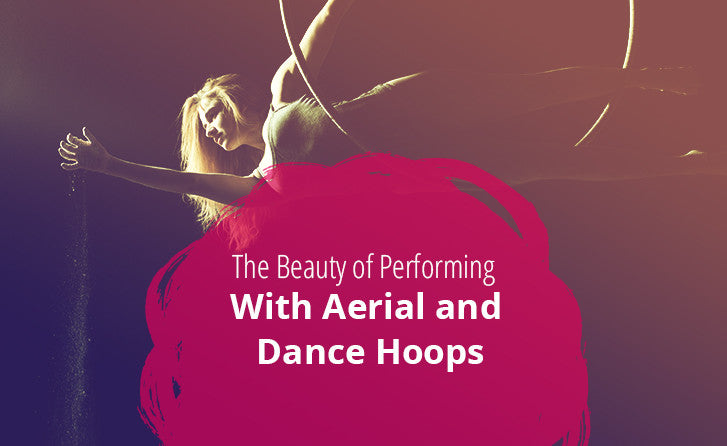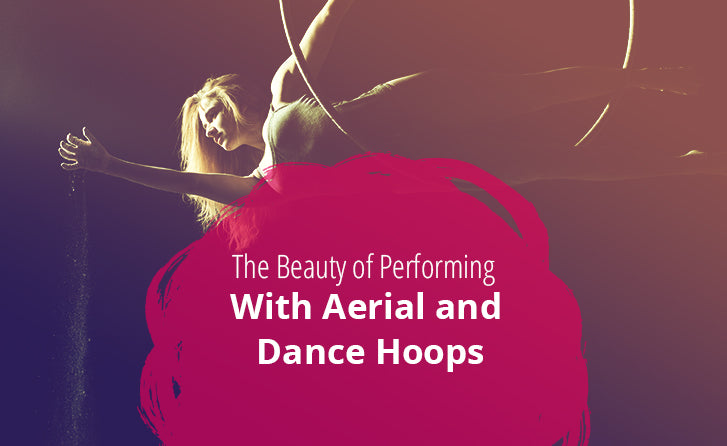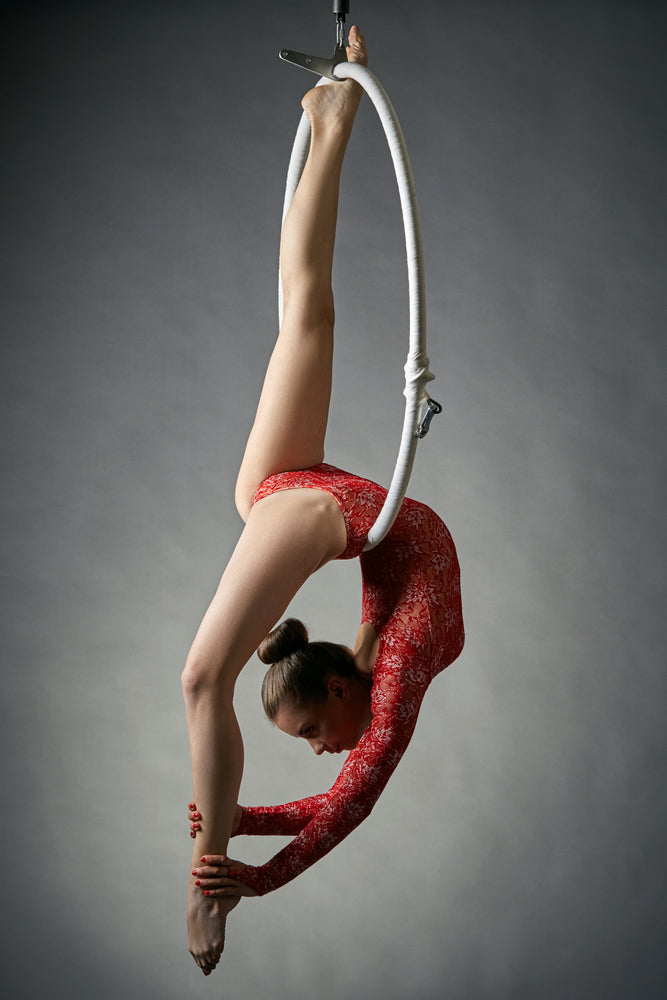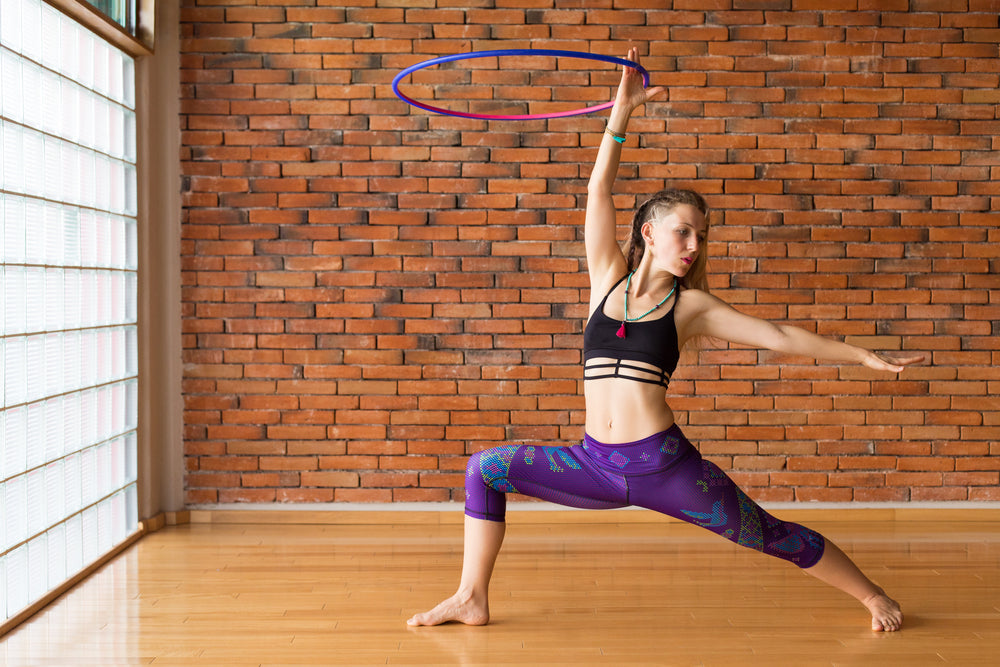
The Beauty of Performing With Aerial and Dance Hoops

Aerial is an acrobatic form of modern dance performed on hanging apparatus, ranging from silks to hoops, that is taking the world by storm. Taking dance to the next level by moving it off the stage and into the sky, aerial defies gravity to create jaw-dropping performances of stunning beauty.
One of the most popular tools used in aerial is a hoop -- in aerial hooping, also known as lyra or cerceau, a dancer swings, hangs, and contorts herself around a hoop hanging from the ceiling to deliver an unforgettable show. The performer swings, spins, and poses around the ring, often hanging by a single leg or arm. Throughout the performance, the hoop can be static, spinning, or swinging (or any combo of all three).
Hoop, There It Is…
Hoops (and aerial) have a long history as accessories in performance and recreation, evolving from other acrobatic performance acts the high wire and the trapeze.
Hoops were first recorded in the 1700s as recreational objects for children at play, but took on a more artistic purpose in the nineteenth century. According to Vertical Wise, the earliest recorded use of the hoop was in an 1893 advertisement in the New York Clipper for a performer named “Caedo” who used the apparatus in his feats of acrobatic strength and skill. Much of aerial hooping technique is derived from gymnastics, which provides the grounding for other aerial feats, including trapeze.
Though hoops were a feature in the circus from 1893 on, hoops have seen an enormous rise in the performance sphere, as well as playing a role in the rise of what is known as “circus fitness.” The aerial hoop first entered more mainstream performance with Cirque du Soleil’s 2002 show Varekai and has become an integral part of their new shows. Indeed, aerial performance as a whole, including hooping and aerial silks, owes a great debt to Cirque du Soleil for introducing the acrobatic techniques to the mainstream as a signature part of their shows.
Pop artist Pink has also brought aerial techniques to the forefront, with her aerial performances at her live concerts and on the Grammy’s in 2010 and 2014. The singer regularly includes aerial training in her fitness routine, working with LA-based trainer Dreya Weber, and her use of the gravity-defying performance art has led to an explosion of circus fitness and aerial classes across the country.
Hoops have also gained traction with the rise of modern burlesque. Burlesque provides many of the modes of expression and techniques for those who choose to train on hoop as entertainers and performers. Many, however, use the beauty of aerial hooping for their own satisfaction. In recent years, pole dancing, acrobatics, and the aerial arts have boomed as popular exercise options, with the rise of “circus fitness.” Many choose to learn the storied art of aerial hooping to increase their own core and upper body strength, as hooping not only requires incredible core strength, but flexibility and strength in the shoulders, arms, and back muscles. Hooping is a beauty to behold not only for the death-defying moves of contortion in the air, but also for the toned bodies of the performers.

They Only Make it Look Easy
When performed by a truly gifted artist, aerial and dance hooping looks graceful, elegant, and perhaps, even easy. A hoopist can appear nearly weightless and impossibly flexible during his or her routine. But to the unsuspecting eye, the hoop presents many challenges to a performer.
Often, before ever taking to the hoop, performers must undergo a strict conditioning and strength regimen to ensure their flexibility and upper body strength are up to the task of hooping. Training often includes pilates, dance warm-ups, and pull-ups on the hoop itself. Instructors may alternate the hoop between a static and swinging position to challenge performers and build core strength.
To train for her aerial stunts, Pink adheres to a regimen of pull-ups and anti-gravity yoga as recommended by her trainer Dreya Weber. Anti-gravity yoga is the practice of suspending yourself from a silk hammock and taking yoga poses -- it doesn’t require the same strength as aerial silks, but promotes muscle use that builds the core and upper body strength required for hoop. Weber also recommends that aerialists give P90X a try to sculpt their body into the muscle machine required to make hooping appear effortlessly graceful to onlookers.
One of the most deceptively challenging aspects of aerial hooping is partner hooping, where two artists perform on a hoop together in a double act. Audience members may assume that partner hooping makes aerial tricks easier, as you rely on your partner for support and strength (in much the same way trapeze artists do). However, partner hooping is actually significantly more challenging, with performers required to not only work against the weight and momentum of the hoop, but their partner’s as well. Partner hooping requires intense strength and work ethic, as partners must rehearse tirelessly to master synchronicity and maintain balance.

Hoop-spiration
Aerial hooping is one of the most beautiful, astonishing art forms around, and whether you’re a casual observer, novice, or devotee, there’s abundant inspiration to be found, especially via social media and Instagram.
Pole Dance Nation runs an Instagram an Aerial Nation account that regularly shares posts from aerial artists around the world. What’s more --they sponsor weekly contests so you can show off your hoop moves and earn a chance to win merchandise and more. The account is also big on inspiration and providing artists with ideas for poses and mantras to boost their confidence.
Beastly Built also runs an Instagram account where they regularly post incredible videos of tricks from aerial hoopists around the world. They re-post the best and most inspiring moves from around the world, and the artists often break down the technique so inspiring aerialists can try them for themselves. While much of their coverage features traditional hoops, they also take care to showcase more unique performances on custom hoops/props, such as oversized chandeliers and more.
Finally, there are also an abundance of individual aerial artists you can follow on social media for your daily dose of inspiration. That_Circus_Freak from Australia is a self-taught circus artist, who has earned over 25,000 Instagram followers with her mind-blowing moves that make her look like a superhero on a hoop.
From Cirque du Soleil to social media, the world of aerial and dance hoops is a beautiful, unique, rising art form with much to offer. Next time you pick up a hoop, you can appreciate the art that goes into incorporating hoops into performance.

1 comment
It’s good that you discussed aerials as an acrobatic form of modern dance that defies gravity to create stunningly beautiful performances with hanging apparatus. I’ve always been interested in seeing one in person, and since I’ll be on vacation next weekend, I’m hoping to catch one live soon. I hope there’s an available aerialist show production nearby that I can check out during my break. https://www.allwheelsports.com/services
Anna Collins
Leave a comment
This site is protected by hCaptcha and the hCaptcha Privacy Policy and Terms of Service apply.